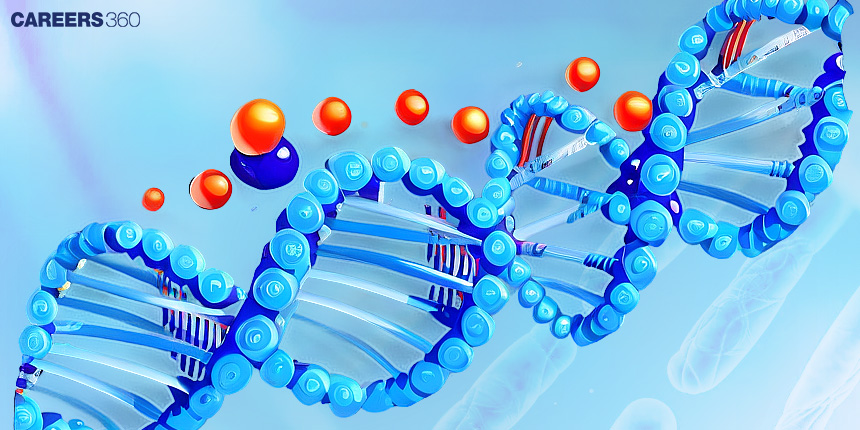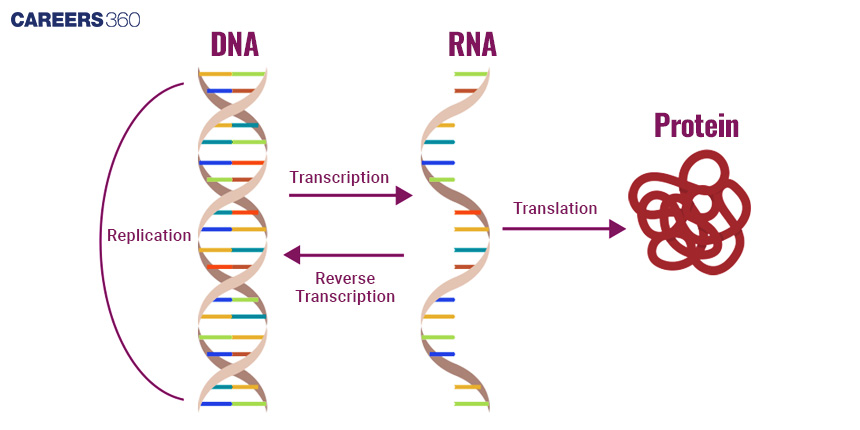Central Dogma of Molecular Biology: Steps and Diagram
What Is The Central Dogma?
The central dogma of molecular biology is the one tenet that tends to explain the flow of genetic information within a cell. It all starts with DNA, the hereditary material or genome that contains the information necessary to make and sustain life. DNA is a double-stranded molecule that is made up of nucleotide bases arranged in a definite sequence.
Latest: NEET 2024 Paper Analysis and Answer Key
Don't Miss: Most scoring concepts for NEET | NEET papers with solutions
New: NEET Syllabus 2025 for Physics, Chemistry, Biology
NEET Important PYQ & Solutions: Physics | Chemistry | Biology | NEET PYQ's (2015-24)
- What Is The Central Dogma?
- Central Dogma Definition
- Diagram: Central Dogma
- Central Dogma Steps
- Genetic Code
- Recommended video for Central Dogma of Molecular Biology
- Applications Of Central Dogma

First, it is transcribed in a very similar molecule called RNA. It is a single-strand molecule to carries genetic information from DNA in the nucleus into the cytoplasm, where the ribosomes are. It differs from DNA because of uses another sugar, namely, ribose instead of deoxyribose, and one of its pyrimidines is uracil instead of thymine. Major types of RNA participating in this process are tRNAs, rRNAs, and above all, mRNAs, which become templates for proteins.
The last step in the central dogma is the translation of RNA into proteins. Proteins consist of amino acids and do anything from structural support and catalysis of biochemical reactions by acting as enzymes. This whole process is essential for the growth, development, and functioning of all living organisms.
Central Dogma Definition
The flow of genetic information from DNA to RNA to proteins is the central dogma of molecular biology. This slaughter makes sure that genes are expressed in a directional manner, necessary for all living organisms.
Diagram: Central Dogma
The diagram below shows the flow of genetic information as per the central dogma.

Central Dogma Steps
Three main steps compose the central dogma: replication, transcribing, and translating.
Replication
Mechanism of DNA Replication: The process of DNA reproduction takes place just prior to cell division so that during cell division, every daughter cell receives a replica of the genetic material.
Enzymes Involved: Several key enzymes are involved, which include DNA polymerase. Other important enzymes include primase which lays down RNA primers and Ligase, an enzyme that seals off gaps between the newly synthesised fragments of DNA.
Transcription
Transcription is the process by which a particular DNA segment is copied into RNA under the activity of the RNA polymerase enzyme. The mRNA takes the genetic information of DNA to the ribosomes in the second place.
RNA Polymerase Function: It binds to the promoter region of the gene. After this, it unwinds the strands of DNA so that it can read the template strand. The polymerase synthesises a complementary RNA strand by adding RNA nucleotides.
Transcriptional Stages: The transcription process can be divided into three major steps:
An initiation step where the RNA polymerase binds the promoter and initiates RNA synthesis
Elongation where RNA polymerase continues to add nucleotides to the chain of growing RNA
A termination step in which a termination signal is encountered by the RNA polymerase, halting and releasing the newly synthesised RNA.
Translation
Translation is the process whereby mRNA sequence is decoded to build proteins. The process takes place within the ribosomes, reading the sequence of mRNA in triplets of nucleotides called codons.
Ribosomes allow the binding of transfer RNA or tRNA molecules to the mRNA. With every tRNA comes an amino acid a building block of proteins that is specific to a particular codon of the mRNA. The other constituents of the ribosome are ribosomal RNA or rRNA.
Steps in Translation: Translation occurs in three major steps,
Initiation, whereby the ribosome assembles around the mRNA and the first tRNA.
Elongation, where tRNAs bring amino acids to the ribosome to be added to the growing polypeptide chain.
Finally, termination, where the ribosome runs into a stop codon and the newly formed protein is released from the ribosome.
Genetic Code
What are the rules for this process? Well, that is what is programmed in the genetic code. It is simply the set of rules by which information encoded within mRNA is translated into proteins. Formed by codons, sequences of three nucleotides corresponding with specific amino acids or to stop signals during the synthesis of proteins, it includes all translation rules.
The near-universality of the genetic code in almost all organisms suggests its fundamental nature in biology. Each codon will then specify just one amino acid but with some redundancy, since more than one codon may code for the same amino acid. For example, the amino acid phenylalanine is encoded by the codons UUU and UUC.
The genetic code consists of start and stop codons. The start codon marks the initiation of translation and thus codes for the amino acid methionine; the sequence is AUG. Stop codons signal the termination of translation, which means the end of the protein. These include UAA, UAG, and UGA.
Genetic code accuracy is the basis for correctly synthesized proteins. Any mutation or error in the genetic code gives rise to malfunctioning proteins with great biological consequences.
Recommended video for Central Dogma of Molecular Biology
Applications Of Central Dogma
Genetic Manipulation and CRISPR: Such is the foundational role of the central dogma in techniques of genetic engineering, such as CRISPR—a tool that can edit the DNA sequence with a high degree of precision. This could have potentially groundbreaking applications in treatments for genetic disorders and Increases in crop resilience, among many others.
Gene Therapy: It is the introduction or modification of genes within a person's cells to prevent or treat disease. The application requires an understanding and manipulation of all the processes described within the central dogma.
Research and Diagnostics: DNA Sequencing Technologies for sequencing DNA that is, decoding its string of letters have transformed biological research and medical diagnostics. They permit identification of the genetic mutations associated with diseases.
PCR (Polymerase Chain Reaction): PCR is a technique used for amplifying specified DNA sequences, and thus it makes the analysis possible from minute amounts of DNA. application in research, forensic science, and medical diagnostics.
Conclusion
The central dogma of molecular biology is considered an integrative concept explaining the flow of genetic information within cells from replication to translation and thus explains how the expression and regulation of genes occur. Second, future perspectives in molecular biology and emerging technologies may further improve the understanding and manipulation of those basic processes for high impacts in medicine, biotechnology, and beyond.
Frequently Asked Questions (FAQs)
It is a concept of the central dogma of molecular biology that explains the information flow from DNA to RNA to proteins.
This is of vital importance if one is to understand how genetic information is passed on and expressed within living things.
The three most important processes are DNA replication, RNA transcription, and protein translation.
The effect of mutation may change the DNA sequence and further can result in changes in the mRNA and the protein that is formed. This will thus affect the traits and functions of the organism.
Genetic engineering, gene therapy, and diagnostics like DNA sequencing and PCR.
Also Read
29 Nov'24 09:31 AM
19 Nov'24 09:26 AM
18 Nov'24 06:45 PM
18 Nov'24 09:29 AM
18 Nov'24 09:18 AM
18 Nov'24 09:01 AM
18 Nov'24 08:37 AM
16 Nov'24 03:45 PM